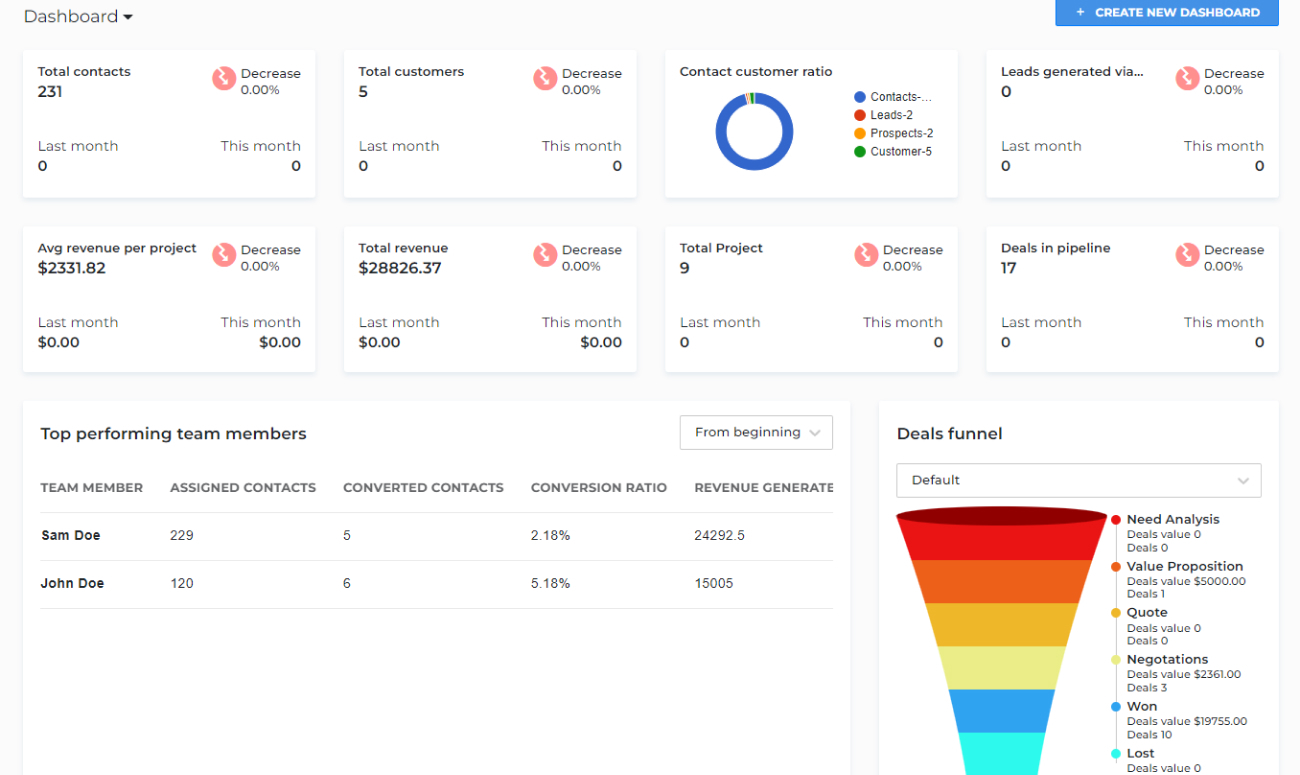
Are you looking to understand your customer requirements better? Or to know your customer’s likings and preferences? Customer relationship management (CRM) systems systematically store customer data and purchase patterns. As CRM software manages all business operations, it is essential for an organization’s success. Businesses can maximize analytical CRM software’ utility by understanding how to leverage data analytics. In this guide, we will show you the steps necessary to unlock your CRM data’s power and generate meaningful insights into customer behavior and engagement with your product or service. Keep reading if you want to gain insight into using analytical CRM, focus to improve business processes, make smarter decisions, increase ROI, and differentiate yourself from competitors.
Introduction to CRM Analytics
CRM analytics is analyzing customer data, patterns, and trends to help inform better decision-making within an organization. It allows businesses to gain insight into how customers interact with their product or service and what changes and improvements need to enhance customer experience.
What is CRM Analytics, and why is it crucial?

Customer Relationship Management (CRM) Analytics uses data and analytical features to examine customer interactions, behaviors, and feedback to improve customer satisfaction and loyalty. CRM Analytics helps businesses gather, analyze, and leverage customer data to make informed decisions, enhance customer experience and drive growth.
In today’s business world, where customers have multiple options, understanding and meeting their needs is essential for business growth. A well-implemented CRM Analytic program can help businesses optimize their resources to deliver exceptional customer experiences and cultivate long-term customer relationships.
It is crucial for businesses as it enables businesses to identify the most valuable customers and understand their buying behavior, preferences, and pain points. By analyzing customer interactions across various channels such as social media, email, phone calls, and offline interactions, businesses can gain insights into customer behavior patterns and tailor their marketing, sales, and customer service strategies to meet specific customer needs.
For instance, American Express used customer data collected through its Analytics program to identify its most profitable customers and offer them more personalized services and incentives. This personalization resulted in a 10% increase in spending among its best customers and a 2.5X increase in customer retention rates.
Smart Analytics also helps businesses to identify and address customer service issues before they escalate. By monitoring their customer interaction data, feedback and online reviews, companies can identify the root cause of customer dissatisfaction, track emerging trends, and take corrective measures to improve customer experience.
For instance, Nordstrom’s leading retail company uses CRM analytics to track customer interactions across multiple channels, including social media. As a result, the company identifies issues highlighted by customers, tracks service response times, and can resolve customer queries quickly and efficiently, leading to higher customer satisfaction rates.
In conclusion, Analytics is crucial for businesses to understand their customers better, increase customer satisfaction and loyalty, and ultimately drive business growth. By leveraging Analytical customer relationship management (CRM) solutions, companies can stay ahead of the competition, optimize resources, and provide exceptional customer experiences.
Key benefits of using CRM Analytics
Innovative customer relationship management (CRM) analytics uses advanced analytical techniques to analyze and derive actionable insights from real-time customer data.
Such business intelligence tools and applications have become increasingly popular across different business units, including sales, marketing, and customer service. Below are some of the crucial benefits of CRM analytics in these areas:

Sales:
Increased sales productivity: Smart sales analytics help teams prioritize their activities by identifying the most promising leads and opportunities.
Improved sales pipeline forecasting: It also allows sales teams to forecast sales pipelines more accurately, allowing them to adjust their strategies accordingly.
Enhanced customer segmentation: By analyzing customer data, sales teams can segment their customer base into various categories, enabling sales reps to target specific customers with personalized offers and campaigns.
Marketing:
Improved targeting: Smart analytics enable marketers to target the right audience with the right message at the right time, increasing conversion rates.
Improved customer engagement: Customer data analysis helps marketers understand customer preferences and behaviors, enabling them to create more targeted and personalized campaigns that resonate with their audience.
Better measurement of marketing ROI: It also enables teams to measure the impact of their campaigns on revenue generation and customer acquisition, allowing them to optimize their marketing spend.
Customer service:
Enhanced customer experience: Analytics enables customer service teams to provide more personalized and proactive service, resulting in higher satisfaction and loyalty.
Improved customer issue resolution: By analyzing customer data, customer service teams can identify and address underlying issues more quickly, resulting in faster resolution times and higher customer satisfaction.
Increased operational efficiency: Smart analytics enable customer service teams to streamline their business processes, and workflows, allowing them to handle a higher volume of requests in less time through customer service evaluations.
In summary, analytics can provide businesses with numerous benefits, enabling them to streamline operations, improve customer experiences, and increase revenues. In addition, by leveraging the power of analytics, companies can gain valuable insights into their customer data, allowing them to make better decisions and take more targeted and practical actions.
What is a CRM Analytics Dashboard?

A CRM Analytics Dashboard is an analytical tool for evaluating sales and marketing operations. It provides real-time, accurate data that lets you track leads and existing customers and improve customer relationships.
By collecting sales data from sources such as company websites, email marketing campaigns, or online advertising programs, a CRM sales dashboard can quickly show sales pipeline and provide analyses of consumer trends and essential business insights into how best to engage with current customers. In addition, this report allows you to lay the foundation for future sales growth while providing your organization with valuable feedback based on measures such as return on investment (ROI).
Analytical CRM Dashboard, businesses have a powerful tool to ensure successful lead management and maximize their sales potential.
Vital elements of CRM Analytics Dashboard
A CRM Analytics Dashboard is a powerful tool that gives businesses insights into customer behavior, sales trends, and revenue growth, among other things. It consists of various key elements such as widgets, matrices, and data visualization tools that display data in graphs, tables, charts, and lists. This way, businesses can quickly gauge their performance and make informed decisions.
Widgets
Widgets are components that perform a specific function and display data in real-time. They are customizable and can place anywhere on the dashboard. For example, a widget may show the number of new leads generated over the past week or the total sales generated by the sales team in a given month.
Matrices
Matrices provide a more comprehensive view of data and are essentially a combination of widgets. For instance, a matrix may display the number of contacts, leads, deals, and revenue generated by a particular sales team. They also provide users with data analysis tools, such as filtering and sorting options, to quickly pinpoint areas where improvements are needed.
Data visualization tools
Data visualization tools, on the other hand, are essential in showing data more graphically. They include charts, graphs, tables, and lists that show trends or patterns in data. For example, a line chart can display the sales trend over a specific period, while a pie chart can show the percentage of sales by product category.
The key benefit of these elements is that they allow businesses to quickly and easily analyze large amounts of data to identify trends, opportunities, and potential issues. Integrating these elements into a CRM Analytics Dashboard enables companies to make data-driven decisions and improve performance.
How to customize a CRM Analytics Dashboard for your business needs
Every business is different, so an analytics Dashboard is not one-size-fits-all. Customizing a dashboard to fit a business’s specific needs is crucial for maximizing its value.

Here are some steps to help you customize an Analytics Dashboard within CRM for your business:
Define your goals: Before customizing a CRM Analytics Dashboard, defining your business’s goals is essential. This step includes identifying the key performance indicators (KPIs) that will help you to measure success.
Identify relevant data sources: Analytical CRM Dashboard can plug many data sources. Identifying the most crucial data sources based on your business needs, unique goals, and strategy is vital. For example, you can use data from your CRM system, marketing automation software, social media channels, and other sources.
Decide on visuals: An Analytical CRM Dashboard should be visually appealing and easy to read and understand. Choosing visuals that make sense for the data you’re presenting is essential. For instance, a graph better shows customer trends over time than a table.
Choose the right metrics: Your chosen metrics should be relevant to your business goals. For sales cloud for example, if one of your goals is to make sales operations increase customer retention, then the metric to track might be the percentage of customers who return to your business after their first purchase.
Use filters: Customizing the dashboard with filters allow you to drill down data quickly and efficiently. You can add filters for geographic location, product interest, or any other criteria that help segment data for analysis.
Keep it simple: A cluttered dashboard can be overwhelming and make it difficult to gain insights. Keeping the dashboard simple and uncluttered means that it is easier to read and it’s easier to derive insights.
For example, if you’re in the e-commerce business, your Analytics Dashboard might look something like this:
Goal: Increase repeat purchases from first-time customers
Metrics: Percentage of first-time customers who have returned to the website, past sales trends, and the average time between purchases.
Data sources: Sales data from the website’s a customer relationship management tool and email marketing data from the marketing automation tool.
Visuals: Line chart showing the percentage of returning customers over time.
Filters: Filter by geographic location, age, and gender.
An Analytics Dashboard explicitly tailored to your business goals and needs can help you make better decisions. It also understands customers better to improve customer loyalty and ultimately drive sales and growth.
Key Metrics to Track in a CRM Analytics Dashboard
CRM analytics tracking can provide crucial insights into a company’s customer relationships and sales performance. A dashboard to track relevant metrics is essential for understanding the customer lifecycle. This tool can measure marketing campaigns, identify target audiences, understand the buying journey, and optimize activities within the company website.
With the help of CRM analysis dashboards, businesses can recognize trends in customer behavior and gain key insights that will lead to better decision-making and improved profitability.
Here are a few key metrics to consider tracking in an Analytics Dashboard:
CRM analytics is a powerful tool for businesses to understand their customers better and enhance their overall experience. This advanced technology can help companies collect and analyze vast amounts of customer data, allowing them to optimize their sales and marketing strategies. Below are the critical metrics of CRM analytics.
Sales metrics

The ability to perform CRM analysis is an essential part of understanding the performance of your sales team. You can see visual omens such as:
Revenue growth
Profit margin
Customer lifetime value
Top performing team member
Deals won ratio
Average deal size and more.
Decision-makers can visualize these metrics in the form of tables and charts. These visuals allow you to gain critical insights into how your sales team is progressing so that you can drive your business forward. Furthermore, these visuals will also help you understand the customer lifecycle better so that you can tailor approaches to yield more significant results.
Marketing performance metrics

To bring maximum efficiency and power to your marketing team’s knowledge and data, allow them to use intelligent analysis on relevant customer relations information such as:
Lead generation
Click-through rates
Conversion rates
Engagement rates
Landing page visits and more.
With this valuable data, they can make informed decisions that will contribute towards sales performance and the overall success of your company website. In addition, by tracking marketing performance metrics, businesses can optimize their marketing efforts to generate better results and improve their overall ROI.
Further, they can analyze the entire customer lifecycle with deeper insight used to create more targeted campaigns; turning a new lead into a long-term client should be simpler using CRM analysis.
Matrices and Widgets
These powerful tools allow businesses to visualize their data and gain insights quickly. They can help companies to identify trends, patterns, and relationships in their customer data, making it easier for them to make informed decisions and take appropriate actions. In addition, businesses can customize the dashboard or widgets per business requirements.
Customer acquisition and retention metrics

Customer analysis is essential for businesses to understand how many people visit their website, how they found it, and what actions they take. In addition, customer analytics can help companies to optimize their marketing campaigns and improve customer retention rates. Key customer acquisition and retention metrics include visitor-to-lead conversion, lead-to-customer conversion, and customer retention rates.
Customer satisfaction and loyalty metrics

These metrics provide actionable insights into customer satisfaction, loyalty, and advocacy. Therefore, businesses must track such metrics to ensure customer satisfaction and retain customers—critical metrics include Net Promoter Score, Customer Satisfaction Score, and Customer Loyalty Index.
In conclusion, businesses need to track the above metrics to optimize their CRM analytics strategy to enhance customer experience, make sales process drive revenue growth, and improve overall performance. With the right CRM analytics tools and a data-driven approach, businesses can gain a competitive edge over their competitors and drive business growth.
How to interpret and analyze data in a CRM Analytics Dashboard
Understand the purpose of the CRM Analytics Dashboard
The dashboard provides insights into customer behavior, the sales cycle, customer life cycle, and the effectiveness of different marketing strategies. However, defining what specific metrics and KPIs need to track in the dashboard is crucial.

Analyze the data visually
The dashboard should provide a range of graphs and visualizations that help to identify trends and patterns in the data. For example, look for spikes or dips in specific metrics, and try to understand what might have caused them.
Identify key customer segments
Most CRM systems and Analytics Dashboards will allow you to segment your customers based on demographics, behavior, and other criteria. Use this segmentation to identify which customer groups are most valuable to your business and which need extra attention.
Monitor changes over time
By tracking changes in key metrics, you can identify whether your marketing and sales strategies are making a difference. For example, are you seeing more customer engagement and higher conversion rates? Or are you failing to hit your targets?
Consider external factors
It’s important to remember that external factors can permanently impact your customer behavior, such as changes in the broader economy or shifts in consumer preferences. Therefore, use external data sources to help inform your analysis of the CRM Analytics Dashboard.
Take action based on your insights
The ultimate goal of CRM Analytics is to use the insights gained to drive action that improves the business. Consider leveraging your findings to optimize your marketing campaigns, your sales processes improve customer engagement, and increase revenue.
Getting Started with CRM Analytics
Businesses should consider implementing a CRM Analytics system with customizable dashboards that allow them to track key metrics in real time and visualize their data quickly. With the right tools, businesses can gain an edge over their competitors and drive business growth.
How to choose the right CRM Analytics tool

When choosing the right and best analytical CRM software tool, there are a few key factors to consider. First and foremost, you want to ensure the system you select is well-suited to your specific needs and goals. That means closely examining your company’s typical sales and marketing processes and any particular pain points or challenges you may be facing.
Another critical consideration when choosing a top CRM platform or analytics tool is its customization level and flexibility. Ideally, you want a system tailored to your unique business requirements rather than one that takes a one-size-fits-all approach. This factor will ensure that you can get the most value out of your investment and that your tool can adapt and evolve as your business needs change.
Additionally, consider the user-friendliness and ease of use of any CRM analytics tool you’re considering. After all, even the most powerful tool in the world will only do you a little good if your team members can figure out how to use it effectively. So look for a platform that offers clear, intuitive interfaces and robust training and support resources to ensure your team can hit the ground running.
Other essential factors to consider when choosing a CRM analytics tool include data security, reliability, pricing, and scalability. By carefully evaluating your options and weighing these various factors, you can ensure that you choose a CRM analytics tool that meets your needs and helps you achieve your business goals.
Final Thoughts
Your data will only take advantage of its full potential once you use it. By understanding what CRM analytics can do for your business, you are one step closer to gaining key insights from your data. Hopefully, this blog post gave you a great starting point in unlocking the power of your data – giving you actionable insight with which to make critical business decisions.
When choosing a top analytical CRM system or predictive analytics solution for your business, be sure it fits all your needs and is tailored towards producing the most accurate results. Ensure that extracting and utilizing data points like customer relationships, acquisitions, behaviors, and issues are also possible within the system. With efficient digital analysis capabilities, it’s now vastly easier to interpret your company’s data and use them to generate advanced studies in more imaginative ways than ever before! Increase engagement and improve clarity rates by driving intelligent marketing efforts with great accuracy – click here to get the best analytical CRM system suitable for smart analytics today!